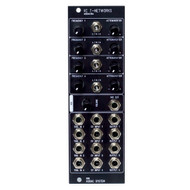ADDAC System — ADDAC104 VC T-Networks
by Ian Rapp
Let me just say this point blank; it was love at first patch for me and Portuguese manufacturer ADDAC System’s new 104 VC T-Networks. I would say love at first sight, but I still get a little apprehensive when it comes to modules that are overall very compactly outfitted—even if it is to put a lot of functionality into a small space—and much of ADDAC’s offerings fall into that design. But like Romeo and Juliet’s courtship, and the unlikely winning combination of chocolate and bacon, love and overall “rightness” has once again conquered.
The 104 doesn’t do much [actually, anything] by itself, and in this case, in MY case, it needs its Juliet, its bacon [assuming the 104 is Romeo and the chocolate], which is the 4ms QCD and expander that I have in my live rack. The QCD has been there for some time, and I’ve always felt that I was under-utilizing it. I don’t have a ton of space [12U x 84HP] in my live case, so I have to be pretty particular about what gets in there, and I try to pack as much punch while still maintaining a live manageability [the 104 fits in perfectly in this aspect], and I just hadn’t found the right drum/percussion module that I could pair with the QCD, and aside from using the it as my master clock I just felt I wasn’t using it to its full potential. But that’s all changed now that the ADDAC 104 has entered my life. But before we talk about how, let’s first go over what this module is, and does.
The ADDAC 104 is a four voice percussion module, and according to ADDAC, is inspired by the twin T-architecture found in many vintage analog drum machines such as the esteemed Roland 808. What is twin T-architecture, you ask? Good question. In practical terms, the actual functionality of the circuit is of a filter being excited into self-oscillating by a pulse, and the reason why certain vintage drum machine circuits are sometimes referred to as “Twin-T” is because—like Moog’s ladder filter and traditional ring modulators—the schematic layout of resistors and capacitors at the heart of the circuit looks like what it’s called; two “T”s. It’s the value of each of the two resistors and capacitors that make up the “T”s that determine the pitch, resonance, and decay of the sound, and other than those components, the circuits for the various percussion sounds [bass, tom, etc.] are the same. The 104 Noiseworks adds CV to each of the four voices and user determined attenuverting for the incoming CV via a potentiometer, something the older drum machines didn’t have, and this is a really excellent addition. Throwing an LFO into the mix, you can have one voice alternate between being both low and high toms, change the snare pitch for accenting purposes, or just add crazy modulation via a non-traditional LFO [like Humble Audio’s Quad operator - see the review in this issue] for crazy percussive, um...craziness.
Each channel has a L/M/H frequency range switch, and ADDAC says that the two top channels are more suited for high end sounds, like rack toms, while the bottom two work better for the lower frequencies and I found this to be the case. At each channel input there’s a gate to trigger converter so anything can be used as a trigger, and when audio inputs are used for this, each voice can be used as a sort of weird filter which can be pretty interesting. Trying out each of the four voices with this and I got everything from a sweeping buzz to a pretty good formant type filter sound. It’s not what I would think to use this for, but it’s an interesting way to “misuse” the 104. There is a summed mix output with a volume control in the middle of the module and four outputs at the bottom; one for each voice. I liked the ability to route my outputs to various effects while still having an overall mix of the four voices. Depending on your size restrictions, having the summed mixer is really beneficial so that you can get 4 drum sounds [more if you modulate them] with only one output,
Getting going with the 104 was quick. Get some triggers in, start dialing in the frequency and you’re off. The ability to CV each of the four voices, and having four voices in such a small space, is why I really like this module. I’ve had a lot of fun with it and paired with the QCD is such a good combination that it’s going to be staying in my live rig for quite a while.
Also available as a DIY kit.
8 HP
Price: $172 / €189.00


